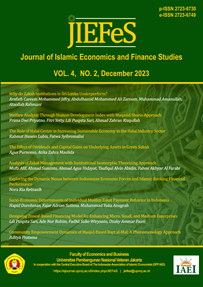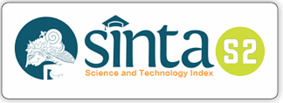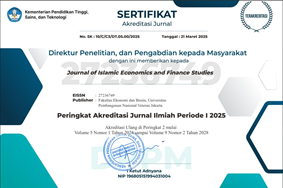Community Empowerment Dynamics of Masjid-Based Bayt al-Mal: A Phenomenology Approach
DOI:
https://doi.org/10.47700/jiefes.v4i2.6618Keywords:
Bayt al-Mal, Empowerment, Masjid, PhenomenologyAbstract
Historically, masjids were the center of government, education, and economy. Nowadays there is an impression that Muslims are only busy to build the physical masjid and are not familiar with reality because Muslims tend to prioritize ceremonial rituals and underestimate the social functions of masjids. This study aims to assess the above assumptions and provide an overview of analytical reviews in capturing the phenomena of the management of masjid-based bayt al-mal. Thus, it can be well recognized the sides of excellence and weaknesses that may exist. This research uses qualitative methods with a phenomenological approach. The research found that there are four phenomena of management of masjid-based bayt al-mal in the Special Province of Yogyakarta namely providing people with social funds through bayt al-mal, empowering people through bayt al-mal, empowering communities not through bayt al-mal. This research emphasizes the evolving roles of masjids, extending beyond mere places of worship. The effectiveness of these multifaceted roles hinges on strong financial management, active fundraising, and transparent utilization of bayt al-mal funds. Training and professional management are also crucial for optimizing resources and building community trust. Masjids can serve as centers of community empowerment and positive social change when embracing their broader roles and responsibilities.
Secara historis, masjid adalah pusat pemerintahan, pendidikan, dan perekonomian. Saat ini ada kesan umat Islam hanya sibuk membangun fisik masjid dan tidak paham dengan kenyataan karena umat Islam cenderung mengutamakan ritual seremonial dan meremehkan fungsi sosial masjid. Penelitian ini bertujuan untuk mengkaji asumsi-asumsi di atas dan memberikan gambaran tinjauan analitis dalam menangkap fenomena pengelolaan masjid berbasis bayt al-mal. Dengan demikian, dapat diketahui dengan baik sisi keunggulan dan kelemahan yang mungkin ada. Penelitian ini menggunakan metode kualitatif dengan pendekatan fenomenologis. Penelitian ini menemukan bahwa terdapat empat fenomena pengelolaan bayt al-mal berbasis masjid di Daerah Istimewa Yogyakarta yaitu pemberian dana sosial kepada masyarakat melalui bayt al-mal, pemberdayaan masyarakat melalui bayt al-mal, pemberdayaan masyarakat tidak melalui bayt al-mal, -mal. Penelitian ini menekankan perubahan peran masjid, tidak hanya sekedar tempat ibadah. Efektivitas peran multifaset ini bergantung pada pengelolaan keuangan yang kuat, penggalangan dana yang aktif, dan pemanfaatan dana bay al-mal yang transparan. Pelatihan dan manajemen profesional juga penting untuk mengoptimalkan sumber daya dan membangun kepercayaan masyarakat. Masjid dapat berfungsi sebagai pusat pemberdayaan masyarakat dan perubahan sosial yang positif ketika menjalankan peran dan tanggung jawab mereka yang lebih luas.
References
Abdel-Hady, Z. M. (2011). The Masjid, Yesterday and Today. The Center for International and Regional Studies, 44(8), 1689–1699.
Adamson, D., & Bromiley, R. (2013). Community empowerment: learning from practice in community regeneration. International Journal of Public Sector Management, 26(3), 190–202.
Adil, M. A. M., Mohd-Sanusi, Z., Jaafar, N. A., Khalid, M. M., & Aziz, A. A. (2013). Financial management practices of mosques in Malaysia. Global Journal Al-Thaqafah, 3(1), 23–29. https://doi.org/10.7187/GJAT302013.03.01
Agung, S., Gautama, Achmad Gat Rahmah, S., & Setiono, A. R. (2022). Religious tolerance, cultural, local wisdom and reliability in the Great Mosque building of Mataram Kotagede Yogyakarta. Journal of Cultural Heritage Management and Sustainable Development, 12(4), 4593–4608. https://doi.org/10.1108/JCHMSD-06-2020-0088
Allaham, A. (2019). Metamorphosis of mosque semiotics From sacred to secular power. International Journal of Architectural Research, 13(1), 204–217. https://doi.org/10.1108/ARCH-11-2018-0001
As-Salafiyah, Rusydiana, A., Mustafa, A. S., & Isa, M. (2022). Maqashid sharia-based mosque empowerment index. International Journal of Ethics and Systems, 38(2), 173–190. https://doi.org/10.1108/IJOES-06-2021-0122
Ayub, M. E. (2005). Manajemen Masjid: Petunjuk Praktis Bagi Para Pengurus (D. Mardanus (ed.)). Gema Insani.
Azzama, A., & Muhyani. (2019). MANAJEMEN MASJID JOGOKARIYAN YOGYAKARTA SEBAGAI PUSAT KEGIATAN MASYARAKAT. Komunika: Juounal of Communication Science and Islamic Da’wah, 3(1), 197–205.
Badan Pusat Statistik. (2020). Sensus Penduduk 2020. https://sensus.bps.go.id/main/index/sp2020
Beik, I. S. (2016). Islamisasi Ilmu Ekonomi. Islamiconomic: Jurnal Ekonomi Islam, 7(2), 183–204.
Boujjoufi, Mohamed El Mustafa, A., & Teller, A. (2023). Does mosque location matter? Mosque and Islamic shops in the European context. Journal of Islamicarketing, Journal of Islamic, 14(2), 465–483. https://doi.org/10.1108/JIMA-01-2021-0007
Creswell, J. W. (2009). Research Design: Qualitative and Quantitative Approaches. Sage Publications.
Emzir. (2014). Metodologi Penelitian Kualitatif Analisis Data (4th ed.). Rajawali Pers.
Fahmi, R. A. (2018). Enhancing The Economic Role Of The Mosque Through Empowerment: A Case Study in Yogyakarta City. Jurnal Ekonomi Manajemen & Bisnis, 19(1), 57–70.
Fahmi, R. A. (2022). Transformation of Mosque Management Through Islamic Social Enterprise Concept. Journal of Islamic Economics Lariba, 8, 157–178. https://doi.org/10.20885/jielariba.vol8.iss1.art10
Fernando, R., Hasanuddin, T., Rangga, K. K., & Utama, D. D. P. (2022). Professional Mosque Management Model Based on Religious and Academic Activities in the Community. Khalifa: Journal of Islamic Education, 6(2), 196. https://doi.org/10.24036/kjie.v6i2.275
Hasan, Z. (1995). Economic Development in Islamic Perspective: Concept, Objectives, and Some Issues. Journal of Islamic Economics, 1(6), 80–111.
Herfandi, H., & Hamdani, F. (2022). Implementasi Sistem Informasi Manajemen Masjid Berbasis Web. INFORMAL: Informatics Journal, 7(3), 167. https://doi.org/10.19184/isj.v7i3.34233
Hutagalung, J., Amrullah, A., Saniman, S., Maya, W. R., & Elfitriani, E. (2022). Digitalisasi Masjid Era Society 5.0 Menggunakan Teknologi Qris Pada Kas Masjid Al-Muslimin. JCES (Journal of Character Education Society), 5(1), 151–160.
Indices, I. (2022). Islamicity Indices 2022. In http://islamicity-index.org/wp/.
Iswanto, Nurjanah, A., Prasojo, I., Anindiyahadi, F., & Raharja, N. M. (2019). Mosque as a Civilization Center. International Journal of Innovative Technology and Exploring Engineering, 8(12), 1072–1074. https://doi.org/10.35940/ijitee.K2345.1081219
Jawahir, M., & Uyuni, B. (2019). Pemberdayaan Masyarakat Berbasis Masjid. Spektra, 1(1), 36–43. https://doi.org/10.30997/qh.v3i1.998
Jaya, E. S., Mahmud, Ruswandi, U., & Erihadiana, M. (2022). The Strategic Management of Mosque-Based Education. International Journal of Current Science Research and Review, 05(06), 2025–2032. https://doi.org/10.47191/ijcsrr/v5-i6-28
Kasri, R. A. (2019). Why do Indonesian Muslims donate through mosques ? International Journal of Islamic and Middle Eastern Finance and Management, 12(5), 663–679. https://doi.org/10.1108/IMEFM-11-2018-0399
Kettani, H. (2010). Muslim Population in Africa: 1950 – 2020. International Journal of Environmental Science and Development, June 2014, 136–142. https://doi.org/10.7763/ijesd.2010.v1.27
Mahomedy, A. C. (2013). Islamic economics: Still in search of an identity. International Journal of Social Economics, 40(6), 556–578. https://doi.org/10.1108/03068291311321857
Muslim, A., Karsidi, R., Wijaya, M., & Joebagio, H. (2014). A Mosque-Based Economic Empowerment Model for Urban Poor Community. International Journal of Social Science Research, 2(2), 80. https://doi.org/10.5296/ijssr.v2i2.5472
Noviriani, E., & Fitriani, A. (2022). Menghadirkan Akuntabilitas dan Transparansi : Langkah Rekonstruksi Pelaporan Keuangan Masjid. Simposium Nasional Akuntansi Vokasi (SNAV), X, 371–379.
Omer, S. (2005). Prophet Muhammad (Pbuh) and Urbanization of Madinah. Research Centre International Islamic University Malaysia.
Omer, S. (2010). Some Lessons from Prophet Muhammad (SAW) in Architecture: The Prophet’s Mosque in Madīnah. Intellectual Discourse, 18(1), 115–140.
Pradesyah, R., Susanti, D. A., & Rahman, A. (2021). Analisis Manajemen Keuangan Masjid. Jurnal Kajian Islam Dan Masyarakat, 4(2), 154–168.
Rehman, S. S., & Askari, H. (2010). An Economic Islamicity Index. Global Economy Journal, 10(3), 1–37.
Rianto, H., Putri, A., & Hasibuan, R. P. S. (2021). Pelatihan Manajemen Masjid Pada Era Industri 4.0. JMM (Jurnal Masyarakat Mandiri), 5(4), 2109–2116. https://doi.org/https://doi.org/10.31764/jmm.v5i4.5061
Riwajanti, N. I., & Fadloli. (2019). Mosque-Based Islamic Cooperative for Community Economic Development. Review of Integrative Business and Economics Research, 8(2), 196–208.
Riwajanti, N. I., Muwidha, M., & Candrawati, T. (2017). Mosque and Economic Development. Annual International Conference On Islam and Civilization, 1(1), 124–129. http://research-report.umm.ac.id/index.php/AICIC/article/view/1935
Said, J., Mohamed, A., Sanusi, Z. M., & Yusuf, S. N. S. (2013). Financial Management Practices in Religious Organizations: An Empirical Evidence of Mosque in Malaysia. International Business Research, 6(7), 111–119. https://doi.org/10.5539/ibr.v6n7p111
Supriyadi, A. (2017). Pemberdayaan Ekonomi Berbasis Masjid(Studi Kritis Pasal 53, 54, Dan 55 Pp. Nomor14 Tahun 2014 Tentang Pelaksanakaan Uu Nomor 23 Tahun 2011Tentang Pengelolaan Zakat). An-Nisbah: Jurnal Ekonomi Syariah, 3(2). https://doi.org/10.21274/an.2017.3.2.210-229
Wahyudin, D. (2020). Mosque and Civilization: Setting Islamic Center of Nusa Tenggara Barat as Center of Civilization. NALAR: Jurnal Peradaban Dan Pemikiran Islam, 4(1), 29–42. https://doi.org/10.23971/njppi.v4i1.1921
Yin, R. (2016). Qualitative Research from Start to Finish. The Guilford Press.
Downloads
Published
Issue
Section
License
Copyright (c) 2023 Aditya Pratama

This work is licensed under a Creative Commons Attribution 4.0 International License.
Authors who publish with this journal agree to the following terms:
- Authors retain copyright and grant the journal right of first publication with the work simultaneously licensed under a Creative Commons Attribution 4.0 International License that allows others to share the work with an acknowledgment of the work's authorship and initial publication in this journal.
- Authors can enter into separate, additional contractual arrangements for the non-exclusive distribution of the journal's published version of the work (e.g., post it to an institutional repository or publish it in a book), with an acknowledgment of its initial publication in this journal.
- Authors are permitted and encouraged to post their work online (e.g., in institutional repositories or on their website) before and during the submission process, as it can lead to productive exchanges, as well as earlier and greater citation of published work.

This work is licensed under a Creative Commons Attribution 4.0 International License.











